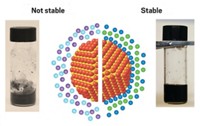Advertisement
Grab your lab coat. Let's get started
Welcome!
Welcome!
Create an account below to get 6 C&EN articles per month, receive newsletters and more - all free.
It seems this is your first time logging in online. Please enter the following information to continue.
As an ACS member you automatically get access to this site. All we need is few more details to create your reading experience.
Not you? Sign in with a different account.
Not you? Sign in with a different account.
ERROR 1
ERROR 1
ERROR 2
ERROR 2
ERROR 2
ERROR 2
ERROR 2
Password and Confirm password must match.
If you have an ACS member number, please enter it here so we can link this account to your membership. (optional)
ERROR 2
ACS values your privacy. By submitting your information, you are gaining access to C&EN and subscribing to our weekly newsletter. We use the information you provide to make your reading experience better, and we will never sell your data to third party members.
Materials
Promoting Fullerene Solubility
Lipid membrane density and packing are key factors for dissolving fullerenes in liposomes
by Jyllian Kemsley
March 3, 2014
| A version of this story appeared in
Volume 92, Issue 9
Fullerenes are touted for a variety of applications, including solar energy and medicine. But their uses are hampered by their limited solubility. One way around the problem is to derivatize the carbon cage. Another is to dissolve fullerenes in the lipid bilayer of artificial vesicles known as liposomes, an approach that is of particular interest for drug delivery. According to a new computational study, key factors promoting dissolution rather than aggregation of fullerenes in lipid membranes are lipid chain density and chain packing (Phys. Rev. Lett. 2014, DOI: 10.1103/physrevlett.112.068102). Jonathan Barnoud, Giulia Rossi, and Luca Monticelli of France’s National Institute of Health & Medical Research examined the thermodynamics of fullerene aggregation in phospholipid membranes as well as in three liquid alkanes. They found that entropy normally drives fullerenes to aggregate. In membranes, however, energy costs associated with solvent density and packing reduce aggregation. The results point to ways to promote dissolution of fullerenes by tuning the chemical composition of lipid bilayers, the researchers say.




Join the conversation
Contact the reporter
Submit a Letter to the Editor for publication
Engage with us on Twitter